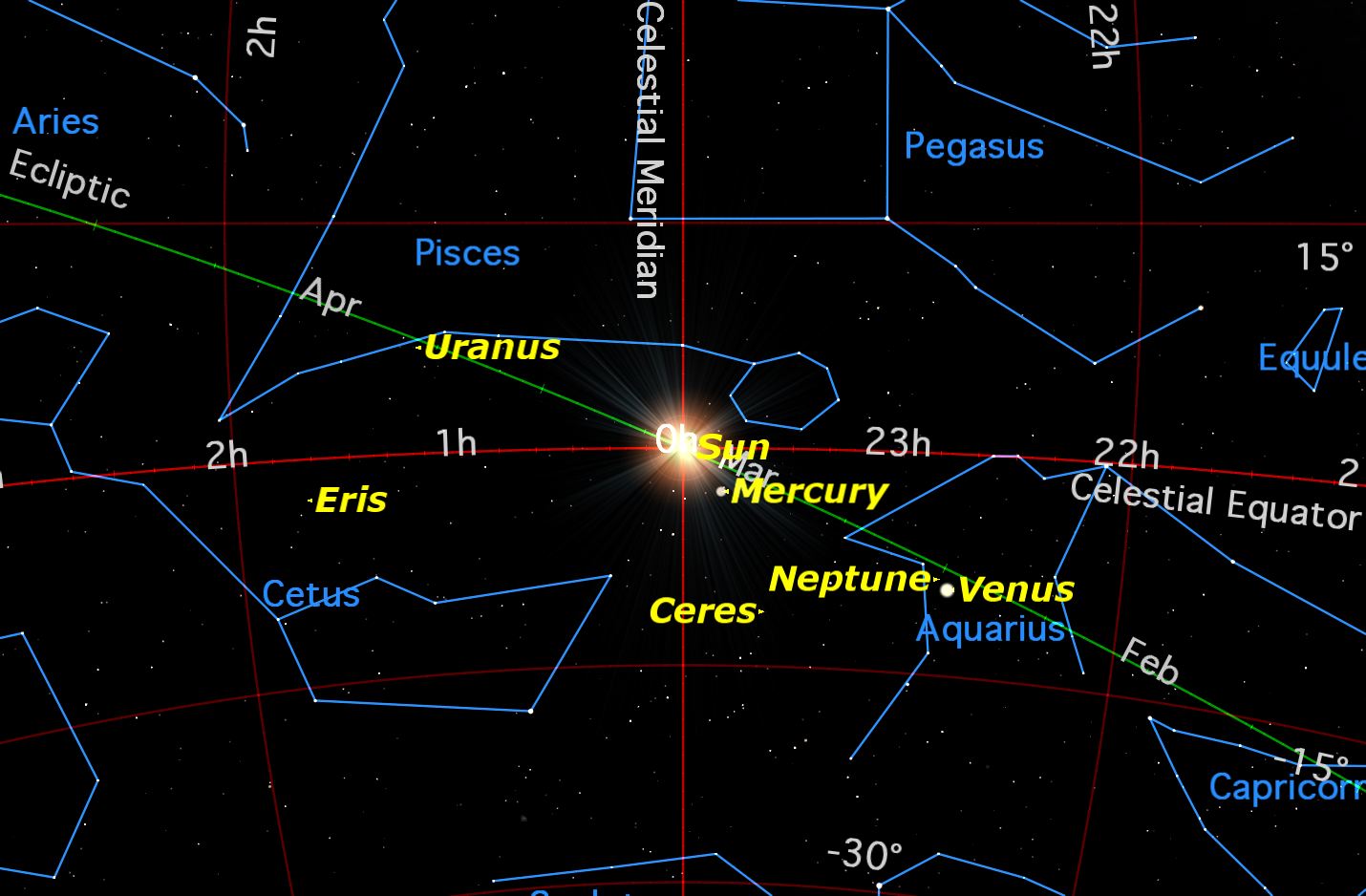Spring Is Here! Check Out the Equinox's Quirky Math

As the Earth makes its annual trek around the sun, certain events are of special importance, both to astronomers and to the public at large. Arguably the most important of these events is the equinox, which occurs this Sunday, March 20, at half an hour past midnight Eastern Daylight Time.
Because of the tilt of the Earth's axis, the sun appears south of the celestial equator for half the year, and north of the equator for the other half. The points of transition from one hemisphere to the other have been extremely important since the beginning of recorded history. If fact, some of the earliest recorded events are astronomical observations of the sun's position.
One of the remarkable things that the first astronomers observed was the position of the sun among the stars. That knowledge is surprising, because no one can see the sun against the starry background, except on the rare occasions when there is a solar eclipse. Yet the earliest astronomers knew that, on the date of equinox, the sun was in the constellation Aries, even though Aries itself would not be visible until a couple of months later.
These ancient scientists made this discovery through careful observations of stars in evening and morning twilight. [The Best Night-Sky Events of 2016: What to Watch for This Year]
Nowadays, skywatchers have computer software like Starry Night, which enables viewers to easily see the sun and stars at the same time on computer screens, so the position of the sun is quite obvious.
If you look at this week's chart, you will see that the sun is nowhere near Aries, currently located almost two constellations distant, in western Pisces close to the border of Aquarius. That is because the Earth, like any spinning top, wobbles on its axis over time, creating a phenomenon called precession of the equinoxes. It takes the Earth 26,000 years to complete one full "wobble." Since the wobble has moved two constellations since astronomers started keeping records, astronomers know that these records started about one-sixth of 26,000 years ago, or around 2300 BCE.
One of the remarkable things that happens on the equinox, giving the event its name, is that day and night are exactly the same length, sunrise and sunset occurring 12 hours apart. Another remarkable thing is that the equinoxes are the only dates in the year when the sun rises due east and sets due west.
Breaking space news, the latest updates on rocket launches, skywatching events and more!
Something that often puzzles people is why the equinox occurs at different times and dates from year to year. In fact, the equinox occurs at exactly the same time on the celestial calendar measured against the starry background. It is Earth's quirky calendar that causes the date to jump around. Because of the extra day thrown in every four years (leap day) to keep the calendar in synch with the stars, the time of equinox goes through a four-year cycle, until a leap year catches it back up. Here's when that cycle has placed the equinox over the last four years:
- 2012: 05:14 GMT
- 2013: 11:02 GMT
- 2014: 16:57 GMT
- 2015: 22:45 GMT
- 2016: 04:30 GMT
Notice that the time of equinox is still slightly out of synch, by 44 minutes, after the normal leap-year correction. This is why there are additional rules in the calendar regarding leap years divisible by 100 and 400 years. [Watch: How an Equinox Looks from Space]
One of the myths around the equinox is that it marks "the first day of spring." The seasons are dependent on local weather conditions, so spring begins on different dates in different places, and also on different dates from year to year in any one place.
Last year around this date, the place where I live in southern Canada was buried in snow. This year, on the same date, the snow is all gone, and the weather feels more like April. In most places, the weather lags about four to six weeks behind the astronomical season markers.
This time of year, the sun provides more warmth to the Northern Hemisphere than in the rest of the year; that's because the sun is rising higher in the sky each day and shining for a longer time. No matter what exactly the weather is doing where you live, enjoy those longer, warmer days.
This article was provided to Space.com by Simulation Curriculum, the leader in space science curriculum solutions and the makers of Starry Night and SkySafari. Follow Starry Night on Twitter @StarryNightEdu. Follow us @Spacedotcom, Facebook and Google+. Original article on Space.com.

Geoff Gaherty was Space.com's Night Sky columnist and in partnership with Starry Night software and a dedicated amateur astronomer who sought to share the wonders of the night sky with the world. Based in Canada, Geoff studied mathematics and physics at McGill University and earned a Ph.D. in anthropology from the University of Toronto, all while pursuing a passion for the night sky and serving as an astronomy communicator. He credited a partial solar eclipse observed in 1946 (at age 5) and his 1957 sighting of the Comet Arend-Roland as a teenager for sparking his interest in amateur astronomy. In 2008, Geoff won the Chant Medal from the Royal Astronomical Society of Canada, an award given to a Canadian amateur astronomer in recognition of their lifetime achievements. Sadly, Geoff passed away July 7, 2016 due to complications from a kidney transplant, but his legacy continues at Starry Night.

